Introduction to Ratangad Trek in Bhandardara, Maharashtra
Embark on the captivating Ratangad Fort Trek, a well-known trekking spot nestled in Maharashtra’s Bhandardara region. Perched at an impressive altitude of 4250 feet, this historic fort is surrounded by the renowned Kalsubai Harishchandragad Wildlife Sanctuary. Spanning across 5 kilometers, the trek to Ratangad offers a moderate-grade experience, boasting spectacular vistas, ancient caves, and seasonal delights like cascading waterfalls and blossoming Karvi flowers. It’s an enchanting journey that promises an unforgettable experience for every trekker.
| Topic – Ratangad Fort | Description |
| History | Details about Ratangad Fort’s historical significance |
| Highlights | Key features or attractions of Ratangad Fort |
| Best Time to Visit | Optimal seasons or months to explore Ratangad Fort |
| How to Reach | Directions or transportation options to reach the fort |
Understanding the Historical Significance of Ratangad Fort
Ratangad Fort is an ancient fortress nestled in the Ratanwadi village of Ahmednagar district, Maharashtra. Situated high above sea level in the Ajoba mountain range, this fort in India is surrounded by the majestic mountains of Kulang, Alang, Kalsubai, Katrabai, Ajoba, and Ghanchakkar. The trek towards Ratangad includes an episode of the challenging descent, making the journey relatively medium-grade. These are estimated to be around 400 to 405 years old, often referred to as the “ghanchakkar,” holds considerable historical significance is due to its strategic positioning in Maharashtra, India.
During the Mughal and British eras, this fort, with its base village at Ratanwadi, served as one of the most determining defence structures. Also, the fort overlooks the Bhandardara Lake adding to its nature appeal, is one of the oldest artificial catchment areas also known as Bhandardara Dam. This fortified ascent to Ratangad and its locale along the ancient trade routes allowed the Maratha Empire to provide a rigorous defence, keeping a vigilant eye on the old trade passages.
Why Ratangad is Called The Crown Jewel of Sahyadris?
Ratangad is often referred to as the “Crown Jewel of Sahyadris” due to its unique geological location and unmatched scenic beauty. Located only 11 km from Randha Falls, Bhandardara, Ratangad fort is the final destination of the vibrant trek to the Jewel fort. The trek location is tucked away in the magnificent Sahyadri Mountains and provides an unparalleled panorama from an altitude of 4255 feet above sea level. Overlooking the tranquil Bhandardara lake, the fort, a prevalent trek location in Maharashtra, offers an opulent spectacle for those desiring an authentic Sahyadris experience.
It serves up breath-taking views of the lake and the highest peaks in Sahyadri, including Kalsubai Peak. Also, the fort is regarded as a marvel of ancient architecture, adding more weight to its “Jewel of Sahyadri” title. Our upcoming night treks, scheduled from next month, offer another layer of thrill for adventure enthusiasts. It proves why Ratangad truly embodies the spirit of Maharashtra treks, both day and night.
Architectural Highlights
Ratangad Fort’s architecture unfolds a saga of its glorious past. Major attractions include the Amruteshwar Temple, a 1200-year-old place of worship dedicated to Lord Shiva, and the towering mountain of Katarabai, all enmeshed with the allure of Ratangad camping. Recognized for its intricate carvings, stunning architectural design and the sheen of its valuable ornaments, this temple reveals an old-world charm.
A highlight of the Ratangad Camping experience, the fort houses ancient structures including several water cisterns and caves, all lying in the grand shadow of the Katarabai mountain. With enough room to host about twenty people, these caves offer an immersive journey into the region’s history. Strategically left devoid of any valuables or ornaments during the warfare years, these structures were a testament to the need for staying light and nimble.
A noteworthy feature is a natural rock peak called ‘Nedhe,’ dubbed as the ‘eye of the needle’. This intriguing formation, much like the piercing gaze of Katarabai, adds a dimension of mystery and adventure to your visit. All these structures exemplify the advanced architectural practices of the era, making the fort, Katarabai, and Rathangad camping, an unforgettable trip back in time.
Highlights of Ratangad Trek Details
Ratangad Trek Details
Here’s a snapshot of the key details about the Ratangad Trek:
- Difficulty Level: Medium
- Endurance Level: Medium
- Altitude: 4255 feet
- Base Village: Ratanwadi or Samrad
- Best Season to Trek: October to February, monsoon and post-monsoon flower season
- Ideal For: Beginners, Intermediate Trekkers
- Outstanding Natural Features: Views of Alang, Madan, Kulang, and Katrabai cliffs, Bhandardara Lake, and occasional sightings of blooming Sonki and Karvi flowers. During pre-monsoon, the surrounding forest area is also known to be filled with the spectacle of fireflies, adding to the ethereal beauty of the trek location.
- Historical Features: Ancient water cisterns, caves, Nedhe (natural rock peak), and the antique Amruteshwar Temple.
Ratangad Trek in Maharashtra is a popular trek location, known for its blend of natural beauty and historical significance, offering an indulgent trekking experience much like the Aadrai Jungle Trek or even the Kalsubai Peak Trek. It’s ideal for the adventure-loving traveller drawn to an intriguing jungle trek. Remember to bring good and reliable trekking shoes; an extra pair of floaters will come in handy too. On your visit, you may also explore various homestay, resort options, and conveniently located hotels in and around the base Village, similar to the facilities available at the noted Bhandardara hiking destination.
Ratangad Trek Route and Its Difficulty Level
The route for the Ratangad Trek usually begins at the base village of Ratanwadi or Samrad. In our overview, the Ratanwadi village part of the journey takes you through a picturesque trail, as the Ratangad Fort flowers trek starts from the nearby Samrad village via the Trimbak Darwaja. The trek feeds you a fair share of challenges, with a label of medium difficulty level. It requires a decent amount of endurance to overcome an The fort is situated at an elevation of around 1192 meters above sea level and has rocks that can be slippery. Additionally, the fort has convenient features such as ladders to make the journey easier.
The Ratangad Fort is not just about its rocky paths. The most attractive aspect today is the naturally growing Ratangad Fort flowers, adding color and life to the landscape. The full trail leading to the fort marked with white arrows on the stones, promises a guided trekking experience. With numerous offshoots veering from the main track, it’s wise to hire a local guide for hustle-free navigation. This trek can get steep and may rattle beginners. However, with appropriate preparation, adequate physical fitness, and guidance, anyone can conquer the fort.
In total, the challenge spans 8-10 km and can take up to 4-6 hours, depending on your speed and fitness level. For any trekker, we recommend wearing comfortable shoes, carrying sufficient water and food, and following the guide’s directives to secure a safe, fun-filled trekking experience.
Essential Information about Ratangad Treks
Duration and Cost of Ratangad Fort Trek
The Ratangad Fort Trek typically takes about 8 hours for a round trip including the exploration of the fort and its surroundings. The time frame can vary depending on the group’s fitness levels, walking speed, and weather conditions. Upon successful booking, customers usually receive a confirmation voucher via email within 24 hours, ensuring a clear communication about itinerary.
For a guided tour, the cost rounds off at about ₹ 1,200. This includes essentials like breakfast, lunch, and evening snacks, guided by professionals. However, the cost might vary with different tour operators, hence it’s advised to confirm via email post booking.
Noticeably, the price may slightly elevate if you decide to camp overnight or need transportation. Special services, If requested, transportation options can include a shared Jeep Pickup from Kasara. Before confirming your booking, always double-check these specifics with your tour provider to ensure a smooth experience. Be wary of the cancellation charges too. Any cancellation made within 7-20 days prior would levy a 60% of total cost, within 0-7 days, a full refund becomes untenable. Ensure to keep a tab on your email for all booking and cancellation related communication.
Important Things to Carry for a Successful Trek
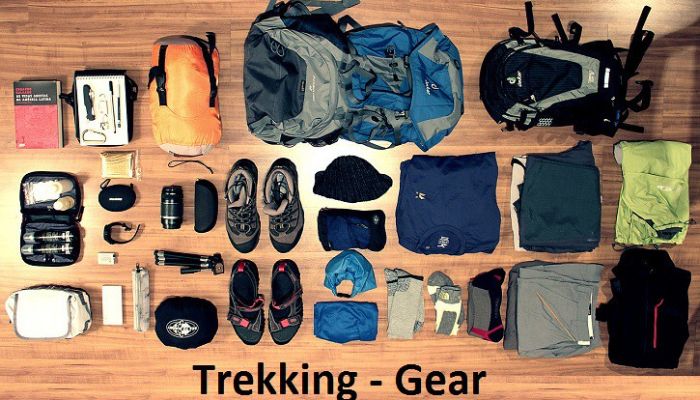 Image Source
Image SourceHaving the right gear can make your trek comfortable, safe, and successful. Given the trail, altitude, terrain, and unpredictable weather conditions of Ratangad Fort, here are a few essential items you should carry:
- Backpack: Opt for a waterproof bag, or one outfitted with a waterproof cover to safeguard your possessions from any sudden showers.
- Trekking Shoes: Select trekking shoes that offer a solid grip to avoid slipping and potential injuries. These should be reliable trekking or sports shoes with sandals, chappals, and floaters not being suitable for such a terrain. Don’t forget to pack an extra pair of socks and consider carrying a pair of floaters as a backup.
- Trekking Essentials: The trek demands lightweight gear; your attire should include trekking pants, a hand napkin/towel, and a Cap/Sun protection cap. Full sleeves t-shirts and track pants are recommended for protecting skin from sun exposure, thorny plants, and insects.
- Water and Food: Staying hydrated is key, so bring at least 2-3 liters of water, and don’t overlook packing ready-to-eat food like dried fruits, biscuits, and nutritious bars.
- First Aid and Medicines: A personal medical kit with essential medicines should always be at hand. A quick-drying towel is also necessary.
- Other Essentials: Your packing list should also include a torch, lightweight raincoat or windcheater, power bank, identity card, sun protection gear, and personal toiletries.
Note: Strive to pack light and only carry what is truly essential. Always have some form of ID proof, such as an Aadhar card or driving license.
Seizing the opportunity to connect with nature requires adequate preparation. Make your trekking journey safe, comfortable, and ultimately, a fulfilling experience!
How to Reach the Ratangad Fort: Complete Guide
Reaching Ratangad Trek From Mumbai
There are several ways for travelers from Mumbai to reach Ratangad trek. The entire journey from Mumbai to the base village, Ratanwadi, The duration of the journey can vary between 5 to 6 hours, depending on the transportation method and traffic conditions.
- By Car: If you prefer driving your own vehicle, start your journey on the NH3 route via Igatpuri to Kasara. Move towards Ghoti-Bhandardara on SH44, and then head to Ratanwadi.
- By Train: Travelers can also take a train from Mumbai to Kasara. From Kasara, State Transport Buses and auto-rickshaws are available till the Bhandardara base. From Bhandardara, one can reach Ratanwadi by auto or jeep.
A common meet-up location for trekkers is Thane, where multiple trekking operators organize transport to the base camp, usually leaving by late evening and reaching the base by early morning for breakfast and the beginning of the trek.
Accessibility to Ratangad Trek From Pune
Traveling from Pune to the base of Ratangad trek, Ratanwadi, is a convenient journey of around 6 to 7 hours. The distance between Pune and the starting point of the Ratangad Fort Flower trek, which is notably based in Ratanwadi, is about 220 kilometers. Here are some ways to reach:
- By Car: If you opt to drive, take the Pune-Nashik Road (NH60). From Sangamner, move towards Akole, then towards Rajur, and finally, reach the village of Ratanwadi, this is the same village from where the magnificent Ratangad Flower trek begins.
- By Bus or Train: The nearest bus station and railway station to reach Ratangad Flower Trek from Pune is at Igatpuri. Buses ply regularly from Pune to Igatpuri. Alternatively, you can also catch a train from Pune to Igatpuri. From Igatpuri, you need to take a local bus or a taxi to the starting point at Samrad village via the Trimbak Darwaja.
Most of the trekking groups arrange bus pickup and transport from Pune directly. It’s advised to check with your trek operator for specific details about the transportation to reach the base point of the Ratangad fort flower trek.
Best Time to Visit in Ratangad Fort Trek
Wonders of Ratangad Trek in Different Seasons
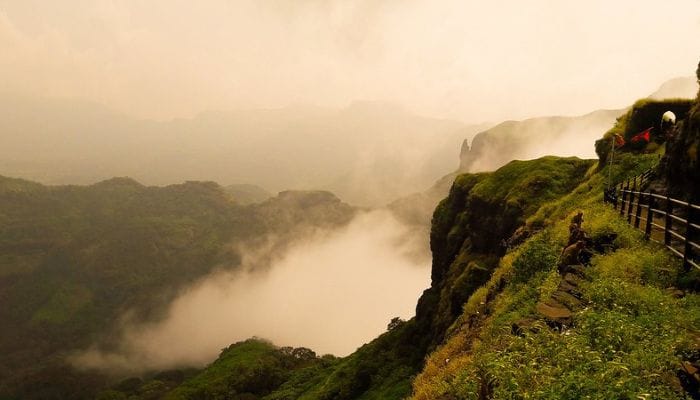 Image Source
Image SourceThe Ratangad Trek offers varying yet equally mesmerizing experiences across different seasons:
- Summer (March to June): During the summer, the days are quite hot but the nights turn pleasantly cool. This is the ideal time for star gazing and nocturnal treks, allowing for an intimate experience with the cosmos. Further, with sparse vegetation, the architectural grandeur of Ratangad Fort and panoramic views of surrounding peaks like Alang, Madan, and Kulang unfold beautifully.
- Monsoon (June to September): The monsoon season wraps the fort in verdant greenery, mist, and seasonal waterfalls, crafting a paradise for nature lovers. Interestingly, this is when the Ratangad karvi flower blooms once in seven years, blanketing the fort in hues of purple and pink adding an alluring charm.
- Winter (October to February): The cool and clear winter weather is perfect for camping in caves, offering a chance to truly immerse yourself in the beauty of the fort and its surroundings. The Ratangad karvi flower trek, which is about six hours from Mumbai and Pune, is a popular tourist attraction in this season.
Remember, each season brings its own set of challenges. Always ensure you’re prepared for the changes in weather and terrain, especially if you’re planning a trek to witness the Ratangad karvi bloom, whichever season you choose for your trek.
Why Monsoon is the Best Time for Ratangad Trek?
While Ratangad Trek is a year-round adventure, there’s something utterly magical about undertaking this journey during the monsoon. Here’s why:
- Surreal Scenery: As the rain starts pouring, Ratangad transforms into a lush green paradise. The trail during the monsoon season is dipped in every possible shade of green and is tranquil, adorned with blooming wildflowers, active streams, and gushing waterfalls.
- Amazing Weather: The cool, humid weather is ideal for trekking, allowing you to escape the sweltering heat of the summer. Plus, it offers a refreshing and rejuvenating experience whilst trekking.
- Misty Atmosphere: The blanket of mist that descends upon the trek, especially early in the morning and in the evening, creates a truly enchanting environment.
However, monsoon also brings slippery trails and reduced visibility due to foggy conditions. Hence, it’s wise to proceed with caution and preferably with experienced trekkers or guides. So, if you’re planning to trek Ratangad, consider experiencing the monsoon beauty of the Sahyadris.
Places to Visit Near Ratangad
1. Harishchandragad Fort
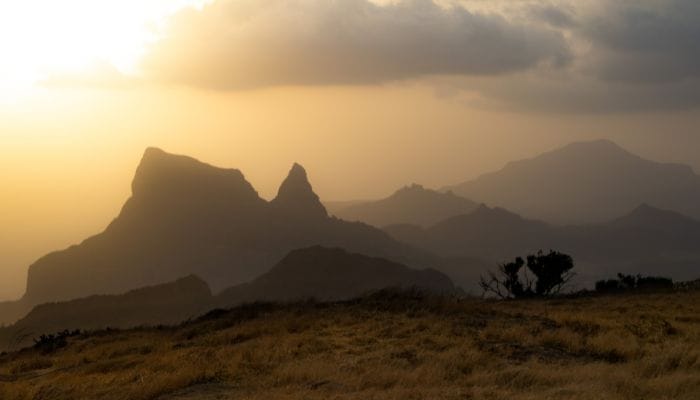
Harishchandragad Fort, located just 30 kilometers away from Ratangad Fort, is a historical fortress perched at an elevation of 1,422 meters in the Ahmednagar district of Maharashtra. This ancient fort is believed to originate back to the 6th century and was once a strategic outpost in various empires, from the Mughals to the Marathas.
Here, you can enjoy several attractions like the Kedareshwar cave, Konkan Kada cliff, and the temple of Harishchandreshwar. From the cliff, you get a panoramic view of the surroundings which is simply awe-inspiring.
Being one of the most sought-after trekking destinations in Maharashtra, the Harishchandragad Fort Trek offers trekkers a bounty of natural beauty including verdant valleys, misty hills, and cascading waterfalls.
Key Features
- Konkan Kada, a renowned cliff at Harishchandragad Fort
- Kedareshwar Cave, an intriguing temple situated in a cave within Harishchandragad Fort
- Taramati Peak, a vantage point providing expansive, panoramic views
- Approximate distance from Ratangad Fort to Harishchandragad Fort is 35 kilometers
2. Sandhan Valley
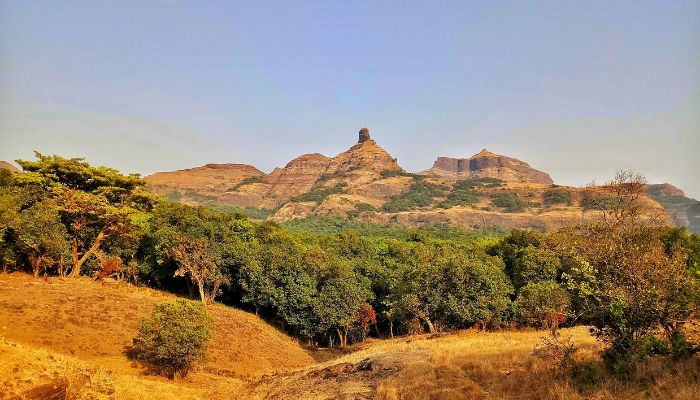
While traveling to Ratangad Fort, exploring Sandhan Valley offers a chance to witness the magnificence of the Sahyadri Range. This valley, often referred to as the ‘Grand Canyon of Maharashtra,’ offers a fantastic trekking experience, blending adventure with breathtaking natural scenery. There, you can have a chance to bask in the remarkable beauty of the surrounding landscape, including steep cliffs and distinct rock formations. It makes your trip to Ratangad Fort much more thrilling and worthwhile.
Key Features
- The unique narrow gorges and canyons of Sandhan Valley
- Opportunities for rock climbing and rappelling at Sandhan Valley
- Sandhan Valley is known for its scenic natural beauty and unique geological features
- It is approximately 40 kilometers distant from Ratangad Fort.
3. Kalsubai Peak
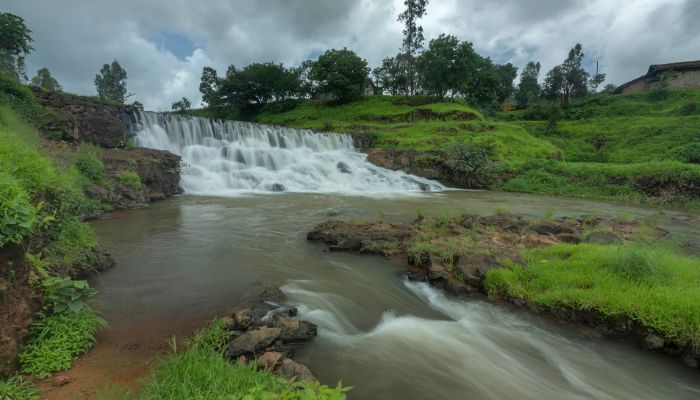
Nestled in the Western Ghats, Kalsubai Peak, also known as the ‘Everest of Maharashtra,’ soars to an impressive altitude of 5400 feet, making it the highest peak in Maharashtra. It’s approximately 22 kilometers from Ratangad fort, offering yet another delightful trekking experience nearby.
During your trek, you’ll navigate through rocky terrains, steep slopes, and ladders to reach the Kalsubai summit. Once at the top, you’re rewarded with a panoramic view of several forts such as Harihargad, Anjaneri, Ghargad, Bahula, Trimbakgad, Harihar, and Ratangad, not to mention the ethereal beauty of the surrounding landscape.
The destination is often frequented by trekkers and pilgrims for the Kalsubai Temple, dedicated to a local deity. It hosts a significant fair locally known as Kalsubai Jatra that attracts a large crowd every year.
The Kalsubai trek, along with its historical relevance and bewitching beauty, promises an incredible experience that will leave you with memories to cherish forever.
Key Features
- Kalsubai Peak’s claim to fame is its status as the highest peak in Maharashtra, offering breathtaking views of the surrounding landscape.
- A key attraction at the summit is the Kalsubai Temple, drawing both locals and tourists alike.
- The trek to the peak is enriched with diverse flora and fauna, making it a must-visit for nature lovers.
- Kalsubai Peak is approximately 60 kilometers away from the Ratangad Fort, making it a popular trekking route.
4. Bhandardara
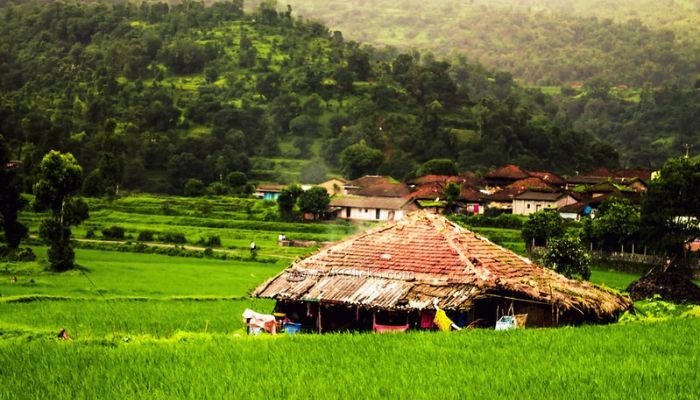 Image Source
Image SourceSituated in the Sahyadri mountains, Bhandardara is a serene hill station that can be found about 22 kilometers away from Ratangad Fort. This place is often coined as the ‘Queen of Sahyadri’ for its pristine natural beauty and relaxing ambiance.
Offering an ambiance of untouched beauty, Bhandardara houses numerous attractions for tourists. The Bhandardara Lake (or Arthur Lake), with the mighty Mt Kalsubai in the backdrop, is a well-known picnic spot. The majestic Randha falls, a 170-feet high waterfall on the Pravara River, is an additional highlight.
For history and architecture admirers, the Amruteshwar Temple, an ancient Shiva temple, showcases beautiful Hemadpanthi style carvings. Also, the Ghatghar viewpoint provides panoramic views of the surrounding hills and valleys.
Bhandardara is a paradise for nature lovers, offering everything from trekking and hiking to boating and picnic spots, making it a perfect getaway destination after your Ratangad Trek.
Key Features
- Arthur Lake: An idyllic reservoir, acclaimed for its captivating serenity and surrounding lush greenery.
- Randha Falls: A visually stunning waterfall in the vicinity that ranks high among the must-visit sights.
- Wilson Dam: Known for providing breathtaking scenic views and a relaxing atmosphere, making it a perfect spot for nature lovers.
- Distance from Ratangad Fort to Bhandardara: Bhandardara is approximately 25 kilometers away from Ratangad Fort, promising a scenic drive for explorers.
5. Amruteshwar Temple
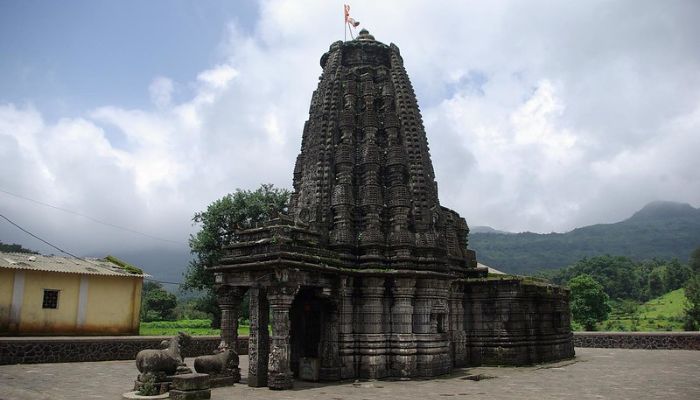 Image Source
Image SourceDedicated to Lord Shiva, the Amruteshwar Temple stands as an epitome of architectural excellence in the foothills of the Ratangad fort. This ancient temple is around 1200 years old and is located comfortably in the village of Ratanwadi, the starting point of the Ratangad trek.
Built in the classical Hemadpanthi architectural style, this temple is known for its intricate carvings of various deities and mythological scenes, including sculptures, on black basalt rock. The temple features a beautiful Shiva-linga in the sanctum sanctorum – an epithet of Lord Shiva. Revised Passage: Built in the classical Hemadpanthi architectural style, this temple is known for its intricate carvings of various deities, mythological scenes, and sculptures on black basalt rock. The temple features a beautiful Shiva-linga in the sanctum sanctorum – an epithet of Lord Shiva.
This temple is not just a pilgrimage point but also a delight for history buffs and architecture lovers. The journey to the temple itself is a visual treat as it is surrounded by bubbling streams and lush paddy fields. A visit to Amruteshwar temple adds a spiritual touch to your adventure-filled trek on Ratangad.
Key Features
- Amruteshwar Temple is an ancient sacred place dedicated to Lord Shiva, featuring intricate engravings that add to its beauty and historical charm.
- Developed in Hemadpanthi architectural style, the temple displays high-quality craftsmanship, which is reflected in its detailed construction, carvings, and designs.
- The temple holds a remarkable spiritual and historical significance in the region, attracting visitors and pilgrims from everywhere.
- Amruteshwar Temple is strategically situated, with a distance of approximately 15 kilometers from the renowned Ratangad Fort.
6. Ratangad Lake
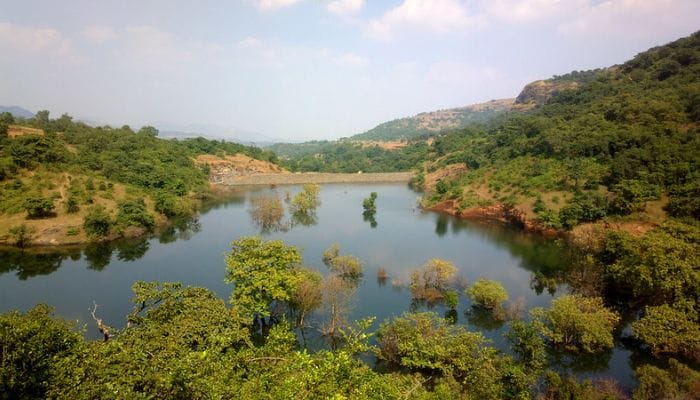 Image Source
Image SourceThe Ratangad Lake, also known as Bhandardara Lake or Arthur Lake, is a beautiful reservoir located at the base of Ratangad Fort. This artificial lake, formed by the damming of the Pravara River, offers serene and sweeping views of the Sahyadri mountains.
The lake is a preferred spot for campers and trekkers alike, courtesy of its tranquil waters surrounded by lush greenery. Not just that, the water body provides important sustenance to a wide array of fauna including different species of fish and birds.
Plan a visit to Ratangad Lake, which is especially delightful during monsoons when the surroundings brim with greenery and the lake is full. For those seeking a quiet moment amid nature, camping at the lakeside under a starlit sky paints an unforgettable picture.
Key Features
- Ratangad Lake is a serene alpine waterbody located in close proximity to the Ratangad Fort.
- Adorned with picturesque views and tranquil surroundings, it adds beautiful scenic charm to the fort.
- Its peaceful and scenic setting makes it a popular camping spot for trekkers visiting Ratangad Fort.
7. Ratanwadi Village
 Image Source
Image SourceRatanwadi Village, the starting point of the Ratangad trek, is one of the most tranquil and picturesque villages lying at the bank of Bhandardara Lake in the Akole tehsil, Ahmednagar district. The village is about 180 kilometers away from Mumbai and 175 kilometers from Pune.
This quaint hamlet is a charming abode to the locals who engage in farming and fishery. It is mainly lauded for the Hetambja Devi temple and the ancient Amruteshwar temple. Trekking, rock climbing, and bird watching are the main attractions for the tourists in Ratanwadi Village.
Moreover, the village presents some unspoiled and raw cultural experiences to visitors. The hospitality of the local villagers, delectable Maharashtrian cuisines, and, most of all, the enchanting homestay experience, add to the overall beauty and charm of the place.
If you plan to trek the Ratangad Fort, an overnight stay at Ratanwadi Village is a must-have experience, to soak up the cultural richness and simplicity of the village life.
Key Features
- Ratanwad Village is a picturesque location nestled in the Sahyadri mountain range.
- The village serves as a gateway to various treks including those to Ratangad Fort and Harishchandragad Fort.
- Famous for its scenic beauty, serene ambiance, and rural charm, making it a appealing destination for tourists and nature enthusiasts.
- Ratanwadi Village is approximately adjacent to Ratangad Fort, making it accessible within trekking distance for adventurers.
Additional Activities Near Ratangad
Exploring Bhandardara Tourism
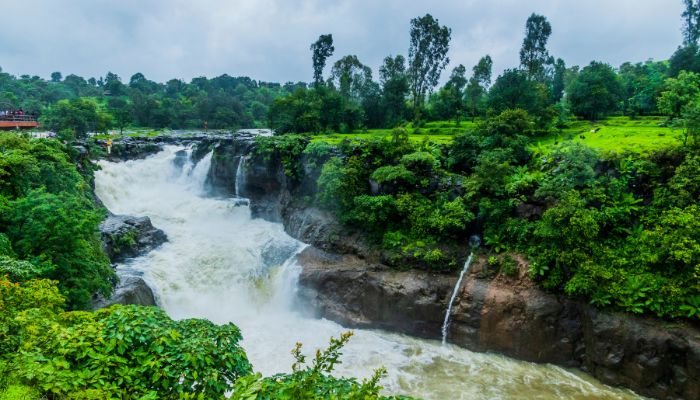
Bhandardara, touted as the ‘Queen of Sahyadri,’ is a beautiful hill station offering a gamut of tourist experiences. Providing an overview, located near Ratangad Fort, it has a series of attractions aligning with the interests of nature lovers, adorable romantics, and adventure enthusiasts.
- Witness Majestic Waterfalls: Randha falls, Bhandardara’s top-notch tourist spot, is an enchanting 170 ft waterfall. Another popular water attraction is the Umbrella falls. This particular waterfall cascades down in a circular form, thereby resembling an umbrella and affording picturesque views.
- Lakes and Dams: The Arthur Lake, formed due to the Wilson dam, offers a tranquil experience with its serene blue water shielded by lush greenery. Adding to the list of attractions is Wilson Dam. Constructed on the Pravara River, it is one of the oldest dams in the country. This venerable structure also boasts beautiful gardens and a circular boat ride.
- Historical Sightseeing: Remains of Fort Agasti Rishi Ashram, an ancient dwelling believed to be of the sage Agasti punch marked during the Mauryan regime, make for a riveting historical attraction.
- Camping and Trekking: Bhandardara is widely recognized for its camping and trekking facilities. For adventure enthusiasts, the hills of Ratangad and Harishchandragad fort present various trekking routes of medium to hard difficulty levels.
From an overview perspective, Bhandardara, with its untamed beauty, is a compelling destination that leaves travelers filled with awe, making them return for more.
Visiting Nearby Points of Interest
Apart from its primary attractions, Ratangad vicinity offers several points of interest that make the journey more enriching:
- Angling: Ratanwadi village situated near the Bhandardara lake is a great place for fishing enthusiasts. A variety of fish, including Catfish and Rohu, are abundant in these waters.
- Mount Kalsubai: Touted as the ‘Everest of Maharashtra,’ this is the highest peak in the state and offers an exhilarating trekking experience.
- Kulangadd Fort: One of the most challenging and satisfying treks in the Sahyadri ranges and a renowned spot for adventure enthusiasts.
- Konkan Kada: A cliff with a 180-degree view of the Konkan plains and a paradise for paragliding enthusiasts.
- Ajoba hill fort: An ideal spot for camping and trekking, this fort is associated with several myths from the Indian epic Ramayana.
Each of these destinations is replete with natural beauty and thrilling experiences, thereby turning your Ratangad trek into a complete vacation experience.
Experience the thrill of trekking near Nashik with its stunning landscapes and adventurous trails. Perfect for nature lovers, these trekking spots near Nashik offer a memorable escape into the great outdoors.
Discover the excitement of adventure parks in Nashik, where thrilling rides and activities await. These parks offer a perfect blend of fun and adventure for all ages.
Frequently asked questions (FAQs)
Is it safe to go on the Ratangad Trek?
Yes, Ratangad Trek is safe for trekkers. The trail is equipped with vigilant trek leaders and responsive staff to ensure the safety and comfort of the visitors. For any traveller interested, there are also various homestay, resort and hotel options conveniently located in and around Ratanagad Village to offer a comfortable stay after a day’s trek. A moderate level of endurance is required due to its medium difficulty level, and taking a guide is often advised to avoid confusion. A traveller from Mumbai could easily get there by Kolkata Mail, Mahanagari Express, arriving at the Igatpuri station. Last year alone, the trek attracted over 20,000 trekkers, further affirming its popularity and reliability among the travelling community.
What is the height of Ratangad Fort?
The height of Ratangad Fort is 4255 feet or approximately 1297 meters above sea level. Located in the Ajoba mountain range, it’s surrounded by the great mountains of Kulang, Alang, Kalsubai, Katrabai, Ajoba, and notably Ghanchakkar. Its impressive height affords spellbinding views of the magnificent Sahyadri range, punctuated by forts like Harishchandragad, Alang, Madan, and Kulang. Moreover, the Bhandardara lake’s captivating vista can also be clearly appreciated from this height, making the trek to Ratangad a truly immersive experience.
What is the Ratangad Fort Trek distance?
The Ratangad Fort Trek distance is approximately six kilometres. You can begin your trek from either Ratanwadi village or Samrad village. When trekking from Ratanvadi Amruteshwar Temple, you gain an elevation of 1480 feet. When trekking from Samrad village via Trimbak Darwaja, the elevation gain is slightly higher at 1600 feet.
What level of difficulty does the Ratangad Trek present?
The difficulty level of the Ratangad Trek is rated as medium. Enhanced by the exhilarating experience of a jungle trek, it’s situated at an approximate height of 4255 feet or 1192 meters above sea level. Like the Aadrai Jungle Trek of Maharashtra, known as an ‘Unexplored Jungle Trek’, this trek too provides an intense connection with nature. Adequate hydration, proper clothing, and reliable hiking footwear are essential necessities. Given the thrill of the adventure, many are intrigued by this trek, therefore, we offer carefully planned out fort itinerary that fits a non-crowded batch for safety reasons. Our batch size is limited, maintaining the quality of experience and safety. We, however, do not conduct a trek with 100-150 people in a group.
Conclusion
Embarking on the Ratangad Fort Trek is a rewarding experience, allowing one to delve into history, challenge physical endurance, and bask in nature’s beauty. The trek, moderately difficult, stands at an altitude of 1296 meters and spans 6 KM. Best pursued between June and February, the journey reveals intricate carvings, stories of the 14th Century Bahmani Sultanate, and panoramic views of the Sahyadri Range. Torchlight on, head towards Ratangad Fort from either Mumbai (178 KM away) or Pune (175 KM away) and immerse in surreal escapade.





Современная клиника оказывает широкий спектр медицинских услуг для всей семьи.
Опытные врачи обладают высокой квалификацией и работают на новейшей аппаратуре.
Мы обеспечиваем комфортные условия для восстановления здоровья.
Мы предлагаем персонализированные медицинские решения для каждого пациента.
Мы заботимся о поддержанию высокого уровня сервиса.
Все клиенты могут рассчитывать на внимательное отношение в удобное время.
bravelight.net
Современная частная клиника предлагает профессиональную медицинскую помощь в любых возрастных категориях.
Мы гарантируем персонализированное лечение и заботу о вашем здоровье.
В клинике работают высококвалифицированные специалисты, применяющие новейшие технологии.
В нашей клинике доступны услуги в различных медицинских направлениях, в числе которых медицинские услуги по восстановлению здоровья.
Забота о вашем здоровье — важнейшая задача нашего коллектива.
Запишитесь на прием, и мы поможем вам вернуться к здоровой жизни.
shipping.evergreen-friends.com
The digital drugstore provides an extensive variety of medications with competitive pricing.
Customers can discover all types of medicines suitable for different health conditions.
Our goal is to keep high-quality products while saving you money.
Speedy and secure shipping guarantees that your medication is delivered promptly.
Experience the convenience of ordering medications online through our service.
https://podcasters.spotify.com/pod/show/tadacip04
This online pharmacy provides an extensive variety of medications at affordable prices.
You can find various medicines for all health requirements.
We work hard to offer safe and effective medications without breaking the bank.
Quick and dependable delivery ensures that your purchase is delivered promptly.
Experience the convenience of getting your meds on our platform.
https://members4.boardhost.com/businessbooks/msg/1728589555.html
На этом ресурсе вы найдете центр ментального здоровья, которая предлагает психологические услуги для людей, страдающих от депрессии и других психологических расстройств. Эта комплексное лечение для восстановления психического здоровья. Врачи нашего центра готовы помочь вам преодолеть трудности и вернуться к сбалансированной жизни. Профессионализм наших психологов подтверждена множеством положительных обратной связи. Обратитесь с нами уже сегодня, чтобы начать путь к лучшей жизни.
http://blueheronherbary.com/__media__/js/netsoltrademark.php?d=empathycenter.ru%2Fpreparations%2Fb%2Fbiperiden%2F
На этом сайте вы найдете центр ментального здоровья, которая предлагает поддержку для людей, страдающих от тревоги и других ментальных расстройств. Наша индивидуальный подход для восстановления ментального здоровья. Наши опытные психологи готовы помочь вам преодолеть психологические барьеры и вернуться к сбалансированной жизни. Опыт наших врачей подтверждена множеством положительных рекомендаций. Свяжитесь с нами уже сегодня, чтобы начать путь к оздоровлению.
drcity.xclub.tw
Stake Online Casino gameathlon.gr is one of the leading cryptocurrency casinos since it integrated crypto into its transactions early on.
Online gambling platforms has expanded significantly and the choices for players are abundant, however, not all of them are created equal.
In this article, we will take a look at the best casinos available in the Greek market and the advantages for players who live in the Greek region.
The best-rated casinos this year are shown in the table below. The following are the top-ranking gambling platforms as rated by our expert team.
For any online casino, it is essential to verify the legal certification, security certificates, and data security policies to confirm security for all users on their websites.
If any of these factors are absent, or if we have difficulty finding them, we do not return to that site.
Casino software developers are another important factor in selecting an internet casino. Generally, if there’s no valid license, you won’t find reliable providers like NetEnt represented on the site.
Reputable casinos offer known payment methods like bank cards, but they should also include electronic payment methods like Skrill and many others.
Доставка грузов в Минске — удобное решение для бизнеса и частных лиц.
Мы предлагаем транспортировку по городу и окрестностей, функционируя каждый день.
В нашем транспортном парке новые транспортные средства разной вместимости, что помогает адаптироваться под любые запросы клиентов.
gruzoperevozki-minsk12.ru
Мы помогаем квартирные переезды, перевозку мебели, строительных материалов, а также компактных посылок.
Наши водители — это квалифицированные работники, знающие маршрутах Минска.
Мы гарантируем оперативную подачу транспорта, осторожную погрузку и доставку в точку назначения.
Подать заявку на грузоперевозку можно через сайт или по звонку с быстрым ответом.
GameAthlon is a popular gaming site offering exciting gameplay for players of all levels.
The platform provides a extensive collection of slot games, live dealer games, table games, and sportsbook.
Players have access to seamless navigation, top-notch visuals, and easy-to-use interfaces on both computer and smartphones.
http://www.gameathlon.gr
GameAthlon takes care of player safety by offering secure payments and reliable game results.
Bonuses and loyalty programs are constantly improved, giving members extra incentives to win and enjoy the game.
The support service is available day and night, helping with any inquiries quickly and efficiently.
The site is the top destination for those looking for fun and big winnings in one reputable space.
GameAthlon is a renowned online casino offering thrilling casino experiences for users of all levels.
The casino offers a extensive collection of slot machines, live casino tables, table games, and sports betting.
Players have access to smooth navigation, stunning animations, and user-friendly interfaces on both desktop and mobile devices.
http://www.gameathlon.gr
GameAthlon takes care of player safety by offering secure payments and transparent RNG systems.
Promotions and special rewards are frequently refreshed, giving registered users extra incentives to win and extend their play.
The helpdesk is ready day and night, assisting with any inquiries quickly and efficiently.
This platform is the perfect place for those looking for an adrenaline rush and exciting rewards in one trusted space.
The GameAthlon platform is a popular gaming site offering dynamic games for gamblers of all preferences.
The casino offers a huge collection of slot machines, real-time games, classic casino games, and sports betting.
Players are offered seamless navigation, high-quality graphics, and intuitive interfaces on both desktop and tablets.
http://www.gameathlon.gr
GameAthlon focuses on player safety by offering secure payments and reliable game results.
Reward programs and VIP perks are constantly improved, giving players extra opportunities to win and extend their play.
The customer support team is available around the clock, supporting with any issues quickly and efficiently.
This platform is the top destination for those looking for fun and huge prizes in one trusted space.
Предоставляем прокат автобусов и микроавтобусов с водителем крупным компаниям, малого и среднего бизнеса, а также для частных клиентов.
Прокат автобусов для свадьбы
Мы обеспечиваем максимально комфортную и надежную транспортировку пассажиров, предусматривая перевозки на торжества, корпоративные праздники, экскурсии и разные мероприятия в регионе Челябинска.
Предоставляем транспортные услуги с автобусами и микроавтобусами крупным компаниям, бизнеса любого масштаба, а также частным заказчикам.
Скидки на заказ автобусов
Гарантируем удобную и спокойную перевозку для групп людей, организуя перевозки на торжества, корпоративные праздники, экскурсии и разные мероприятия в Челябинске и Челябинской области.
В грядущем году в мире моды будут интересные тренды. Дизайнеры акцентируют внимание на природные фактуры и экстравагантные формы. Среди оттенков преобладают приглушенные тона, однако сочные акценты не останутся в стороне. Модные дома сфокусированы на объемных дополнениях. Актуальны старинные мотивы и современный почерк.
https://sxemazarabotka.ru/forums/topic/strah-nochi/page/3/#post-791035
Swiss watches have long been a gold standard in horology. Expertly made by renowned brands, they perfectly unite tradition with cutting-edge engineering.
All elements embody exceptional attention to detail, from intricate mechanisms to luxurious elements.
Wearing a timepiece is not just about telling time. It represents refined taste and heritage craftsmanship.
Be it a classic design, Swiss watches deliver remarkable beauty that lasts for generations.
https://forum.game-kosmos.org/index.php?threads/online-casino-tricks-to-win-h948of.16692/#post-23597
Exquisite wristwatches have long been a gold standard in horology. Crafted by legendary watchmakers, they perfectly unite classic techniques with cutting-edge engineering.
Every component reflect superior quality, from intricate mechanisms to luxurious materials.
Owning a timepiece is not just about telling time. It stands for refined taste and heritage craftsmanship.
No matter if you love a minimalist aesthetic, Swiss watches deliver extraordinary precision that stands the test of time.
https://tuyendungthainguyen.com/threads/whats-your-favorite-timepiece-brand.184455/
Даркнет — это анонимная зона онлайн-пространства, доступ к которой исключительно через защищенные браузеры, такие как Tor.
В этой среде можно найти легальные , например, магазины и другие сервисы.
Одной из известных платформ считается BlackSprut, что предлагала торговле различных товаров.
bs2best
Подобные сайты нередко функционируют на анонимные платежи в целях конфиденциальности сделок.
Прохождение сертификации на территории РФ по-прежнему считается неотъемлемым этапом обеспечения безопасности товаров.
Система сертификации обеспечивает соответствие техническим регламентам и правилам, а это защищает потребителей от небезопасной продукции.
сертификация
К тому же, наличие сертификатов способствует сотрудничество с партнерами и открывает возможности для бизнеса.
Без сертификации, возможны юридические риски и ограничения в процессе реализации продукции.
Вот почему, официальное подтверждение качества не только требованием законодательства, а также залогом для успешного развития организации на отечественном рынке.
Darknet — это закрытая область сети, куда открывается доступ только через шифрованные соединения, например, через Tor.
Здесь можно найти легальные , включая магазины и прочие сервисы.
Одной из таких платформ является Black Sprut, которая предлагала торговле различных товаров.
bs2best актуальная ссылка
Эти ресурсы довольно часто функционируют на криптовалюту для обеспечения конфиденциальности транзакций.
Our store provides a vast selection of certified medicines to suit your health requirements.
Our platform provides speedy and reliable order processing to your location.
All products comes from certified manufacturers for guaranteed safety and quality.
Easily explore our catalog and get your medicines in minutes.
Got any concerns? Customer service are here to help whenever you need.
Stay healthy with affordable online pharmacy!
https://anuneo.fr/centre-medical-dispensaire-marseille-polyclinique-la-feuilleraie
Оформление сертификатов на территории РФ по-прежнему считается важным процессом легальной реализации товаров.
Процедура подтверждения качества гарантирует соответствие техническим регламентам и законам, а это защищает потребителей от некачественных товаров.
сертификация товаров
Также наличие сертификатов способствует взаимодействие с заказчиками и повышает конкурентные преимущества в предпринимательской деятельности.
При отсутствии сертификатов, не исключены проблемы с законом и барьеры в процессе реализации продукции.
Таким образом, получение сертификатов не просто формальностью, а также залогом устойчивого роста компании на отечественном рынке.
Ordering medications on the internet can be way simpler than visiting a local drugstore.
No need to wait in line or worry about limited availability.
Internet drugstores allow you to get what you need without leaving your house.
A lot of digital pharmacies offer special deals in contrast to traditional drugstores.
http://www.ttownsendbrown.com/forum/viewtopic.php?f=42&t=1478
On top of that, it’s possible to compare different brands easily.
Quick delivery adds to the ease.
What do you think about buying medicine online?
Regardless of the popularity of digital timepieces, classic wristwatches are still everlasting.
Collectors and watch lovers admire the craftsmanship that goes into classic automatics.
Compared to smartwatches, which lose relevance, mechanical watches stay relevant through generations.
https://forum.banknotes.cz/viewtopic.php?t=67046
Luxury brands continue to release limited-edition mechanical models, showing that demand for them hasn’t faded.
To a lot of people, a traditional wristwatch is not just a way to tell time, but a tribute to heritage.
Though digital watches offer convenience, mechanical watches have soul that stands the test of time.
Обзор BlackSprut: ключевые особенности
BlackSprut удостаивается интерес широкой аудитории. В чем его особенности?
Эта площадка предоставляет широкие возможности для тех, кто им интересуется. Визуальная составляющая системы характеризуется удобством, что делает платформу интуитивно удобной даже для тех, кто впервые сталкивается с подобными сервисами.
Стоит учитывать, что данная система имеет свои особенности, которые формируют его имидж в определенной среде.
Обсуждая BlackSprut, нельзя не упомянуть, что многие пользователи имеют разные мнения о нем. Одни отмечают его функциональность, а некоторые относятся к нему с осторожностью.
Подводя итоги, BlackSprut остается предметом обсуждений и привлекает заинтересованность разных слоев интернет-сообщества.
Где найти актуальный линк на BlackSprut?
Хотите найти актуальное ссылку на БлэкСпрут? Это можно сделать здесь.
bs2best
Сайт часто обновляет адреса, поэтому важно иметь обновленный линк.
Мы мониторим за актуальными доменами и готовы предоставить актуальным зеркалом.
Проверьте рабочую ссылку прямо сейчас!
Что такое BlackSprut?
BlackSprut удостаивается внимание разных сообществ. Почему о нем говорят?
Эта площадка предлагает разнообразные возможности для своих пользователей. Оформление системы выделяется простотой, что позволяет ей быть понятной без сложного обучения.
Важно отметить, что данная система имеет свои особенности, которые делают его особенным на рынке.
При рассмотрении BlackSprut важно учитывать, что определенная аудитория имеют разные мнения о нем. Некоторые подчеркивают его возможности, а кто-то рассматривают более критично.
Таким образом, эта платформа продолжает быть предметом обсуждений и удерживает интерес разных слоев интернет-сообщества.
Доступ к БлэкСпрут – проверьте здесь
Если нужен обновленный сайт BlackSprut, вы на верном пути.
bs2best актуальная ссылка
Иногда платформа меняет адрес, и тогда приходится искать новое ссылку.
Мы мониторим за актуальными доменами и готовы поделиться актуальным линком.
Проверьте актуальную ссылку прямо сейчас!
Purchasing medicine on the internet is far simpler than going to a physical pharmacy.
No need to stand in queues or think about closing times.
E-pharmacies allow you to buy what you need from home.
Many websites offer discounts unlike brick-and-mortar pharmacies.
https://rantcave.com/showthread.php?tid=19723&pid=111520#pid111520
Plus, you can check alternative medications quickly.
Quick delivery makes it even more convenient.
Do you prefer ordering from e-pharmacies?
Наша компания предлагает сопровождением приезжих в северной столице.
Мы помогаем в получении разрешений, прописки, и вопросах, для официального трудоустройства.
Наша команда разъясняют по миграционным нормам и дают советы оптимальные варианты.
Мы работаем в оформлении ВНЖ, так и с гражданством.
С нами, вы сможете быстрее адаптироваться, решить все юридические формальности и спокойно жить в Санкт-Петербурге.
Обращайтесь, и мы подробно расскажем обо всех возможностях!
https://spb-migrant.ru/
Обзор BlackSprut: ключевые особенности
BlackSprut привлекает обсуждения разных сообществ. Почему о нем говорят?
Этот проект обеспечивает интересные опции для своих пользователей. Интерфейс системы отличается простотой, что позволяет ей быть интуитивно удобной без сложного обучения.
Стоит учитывать, что данная система имеет свои особенности, которые формируют его имидж в своей нише.
Говоря о BlackSprut, стоит отметить, что многие пользователи выражают неоднозначные взгляды. Многие отмечают его функциональность, а кто-то оценивают его неоднозначно.
Таким образом, эта платформа продолжает быть темой дискуссий и удерживает интерес широкой аудитории.
Рабочее зеркало к BlackSprut – узнайте у нас
Если ищете актуальный сайт БлэкСпрут, то вы по адресу.
bs2best at
Сайт может меняться, и лучше знать актуальный домен.
Мы мониторим за изменениями и готовы предоставить новым зеркалом.
Проверьте актуальную версию сайта у нас!
This website provides access to a large variety of slot games, ideal for both beginners and experienced users.
Right here, you can explore classic slots, feature-rich games, and huge-win machines with stunning graphics and dynamic music.
If you are a fan of minimal mechanics or seek complex features, you’re sure to find something that suits you.
https://lorenzogqzi18529.blogdiloz.com/32771800/Что-такое-plinko-и-как-стать-мастером-в-этой-увлекательной-игре
Each title are available around the clock, no download needed, and fully optimized for both desktop and smartphone.
In addition to games, the site provides slot guides, special offers, and community opinions to help you choose.
Register today, jump into the action, and get immersed in the thrill of online slots!
This online store offers a large assortment of stylish wall clocks for your interior.
You can explore urban and vintage styles to fit your apartment.
Each piece is curated for its craftsmanship and durability.
Whether you’re decorating a functional kitchen, there’s always a fitting clock waiting for you.
la crosse alarm clocks
The shop is regularly refreshed with exclusive releases.
We ensure secure delivery, so your order is always in trusted service.
Start your journey to enhanced interiors with just a few clicks.